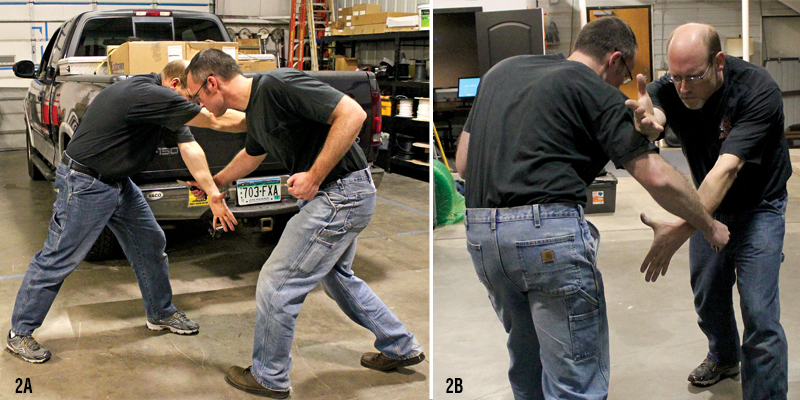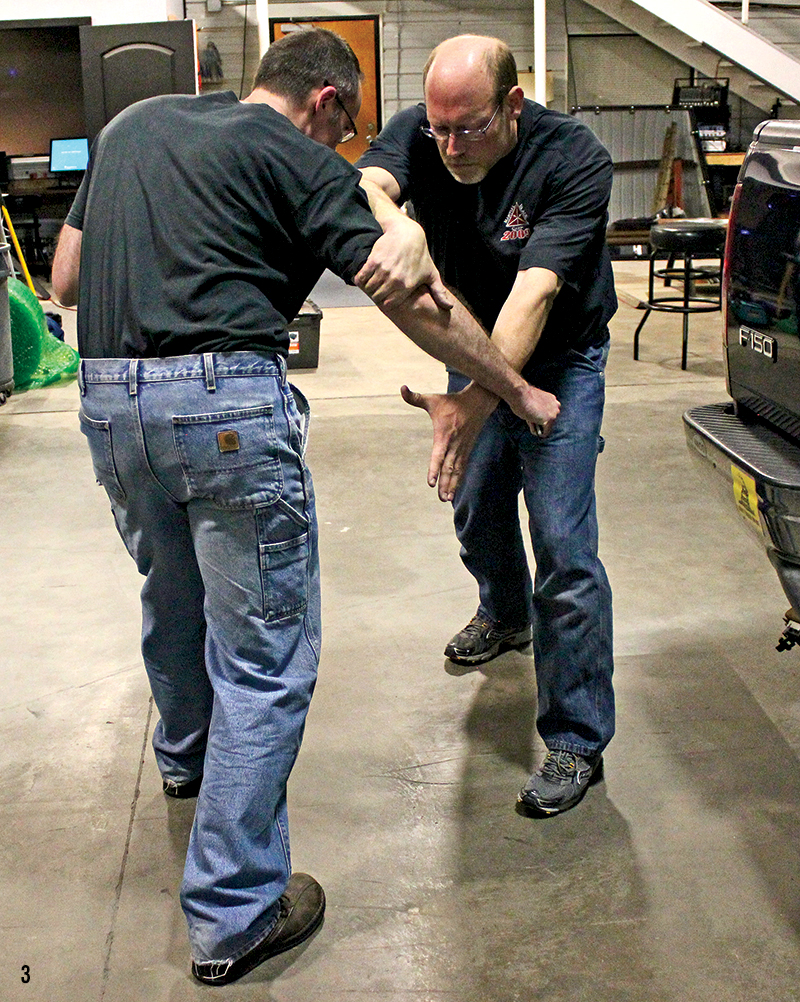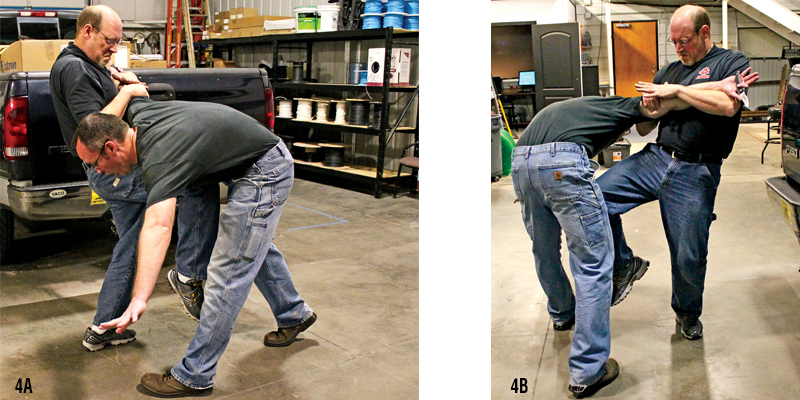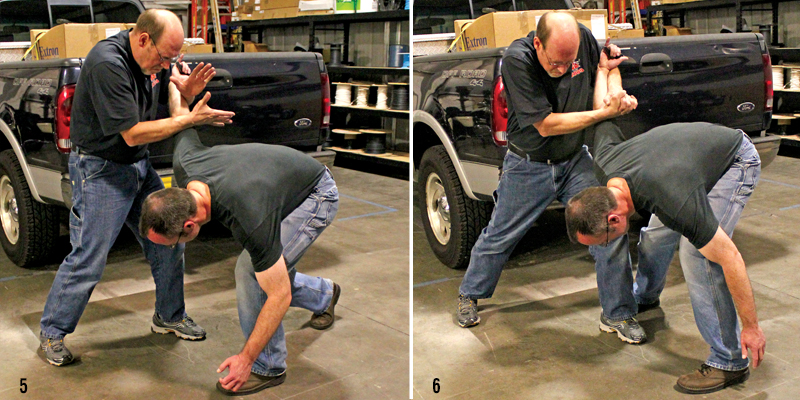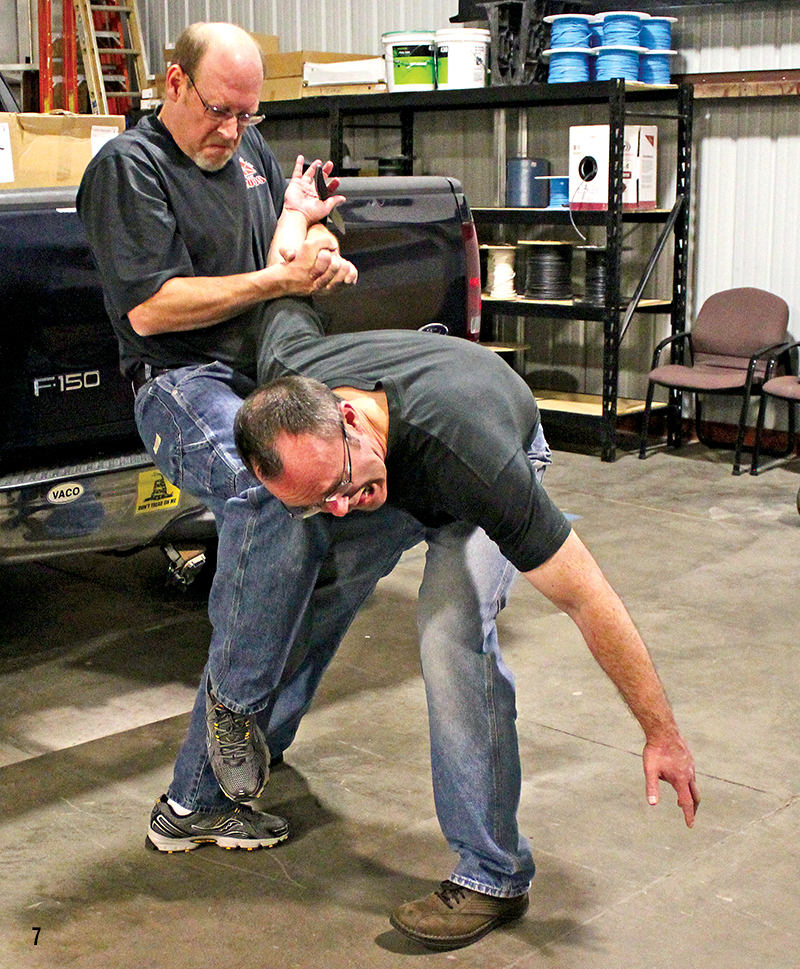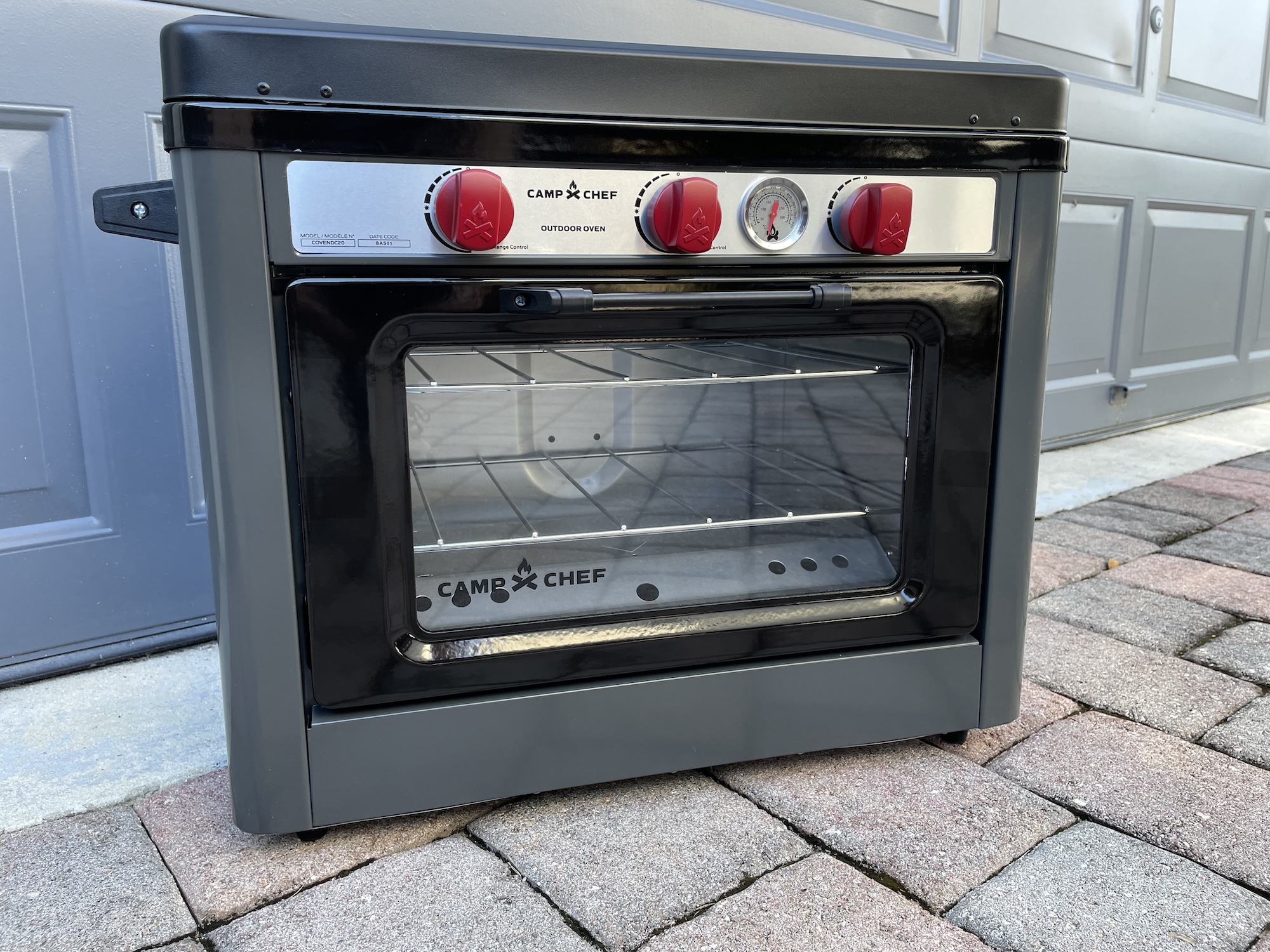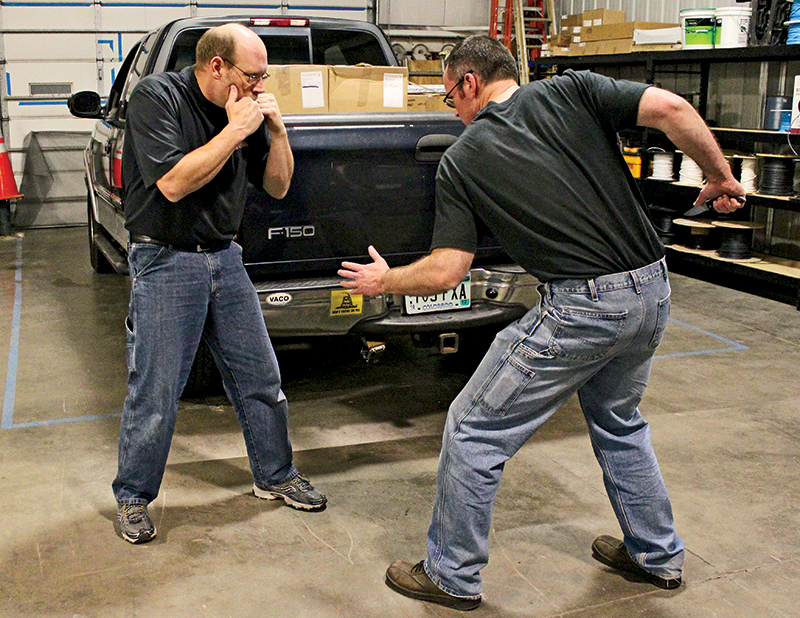
AC0314_BLADE1_Feature
Skills To Help You Survive
Edged-Weapon Attacks.
Facing an attacker armed with a knife or another edged weapon is one of the most terrifying situations you could ever imagine. While many martial arts and defensive tactics systems claim to teach defenses that will work against a knife attack, the more you learn about the reality of how people attack with knives, the more you’ll realize there really are no guarantees.
Unfortunately, much of what’s taught in the law enforcement community with regard to edged-weapon defenses is based more on well-worn clichés than sound tactics. While I admit I laughed out loud the first time I heard the “he brought a knife to a gunfight” line, it gets old very quickly. It’s also a lousy excuse for failing to train in the skills you really need to survive a knife attack.
Defining The Problem
The best way to understand what you need to do to survive an edged-weapon attack is to first understand and accept the brutal reality of those attacks and separate it from the exaggerated, overly choreographed counter-knife techniques taught in most martial arts schools. Once you understand how knife attacks really happen, you can identify their common characteristics and define “the problem.” A clear, realistic understanding of the problem is the only way to develop a sound solution.
My approach to empty-hand defenses against edged-weapon attacks is called Counter-Blade Concepts, or CBC. It’s based on years of analysis of actual knife attacks, interviews with survivors and legitimate research from the medical community. I’ve collected video footage of knife attacks from all over the world and they share many common characteristics. Specifically, knife attacks typically happen as follows:
• They start at close range.
• Typically, the weapon is not brandished before the attack.
• Most people are right-handed (about 90%), so most knife attacks are right-handed.
• Attackers typically use gross motor skills, which are primarily forehand motions.
• Attacks involve repetitive motions, not a single cut or thrust.
• The non-weapon hand is almost always used to grab and gauge distance.
Since these common traits define a typical knife attack, whatever defensive techniques you choose must work in the context of these realities. If they don’t, they’ll most likely fail on the street.
Finding A Good Technique
After more than 35 years of training in the martial arts, I’m firmly convinced the best sources of counter-knife tactics are systems that focus on practical, street-realistic knife applications. After all, if they can cut well, they probably have a good idea of what it takes not to get cut.
The Filipino and Indonesian martial arts include some of the most effective small-knife systems ever developed. They also provide a great foundation of knowledge on effective knife defenses; however, these systems are often very skill intensive and many of their tactics are not consistent with the legal concerns of modern society. I’ve extracted the core concepts of these systems’ proven knife defenses, made them easier to learn and apply and kept them consistent with ethical use-of-force guidelines. CBC is the result of that process.
Order Of Operations
Based on the common characteristics of actual knife attacks, the CBC system uses a logical sequence of actions as the basis for all of its defensive tactics. This sequence is as follows:
• Minimize injury to you.
• If possible, counter and disable immediately to create an opportunity to draw your own weapon.
• If you cannot disable the attacker immediately, maintain contact and control the attacking limb, limiting its mobility to the shoulder joint.
• Create a power base to attack and disable.
• If appropriate and no other threats are present, restrain, control and disarm.
• If control is not appropriate, break contact, draw your weapon (if possible) and be prepared to follow up.
• If the non-weapon arm is presented first, control it and use it as a barrier against the knife hand.
Regardless of their culture or country, people instinctively attack with knives in basically the same ways. The most common method is to grip the knife in a standard grip (with the blade extending from the thumb side of the hand) to attempt to grab, probe or measure distance with the non-knife hand, and to thrust with an upward arc straight up the centerline of the body into the lower torso. Also known as a “Low Angle 5” attack in CBC, this is by far the most common type of knife attack. It is therefore the focus of the first and most important defense taught in the CBC system: The Split-X Block.
The Split-X
The Split-X is similar to the “X” blocks seen in many traditional martial arts in that the extended arms cross in front of your body; however, they don’t touch each other at the wrists. Blocking with your wrists crossed reduces the surface area of your block and makes it very easy for the attacker to trap both your arms by simply pushing down on your wrists.
Although deceptively simple in appearance, the Split-X is incredibly powerful. When teaching seminars I typically demonstrate the technique a few times and then choose a novice student significantly smaller in stature than me. Despite 50- to 70-pound weight discrepancies, beginning students routinely stop near-full-power thrusts with this tactic after only a few minutes of training.
When the attacker thrusts with the knife in his right hand, drive your left arm low and slightly to your right so the back of your forearm impacts the attacker’s inner forearm (Photos 2a and 2b). Simultaneously, drive your right arm high so the back of that forearm strikes the attacker’s upper arm just above the elbow. At full extension, both your arms should be slightly crossed with your fingers open and your thumbs pointing up. This locks the skeletal structure of the arms and creates an extremely powerful block. As you do this, you will naturally “hollow out” — drawing your hips and stomach back to stay away from the point of the knife.
After surviving the initial thrust, you must immediately control the attacker’s arm to make sure he can’t stab again. This is critical, since most attacks involve repetitive motions. From the Split-X block position, simply turn your right hand from thumb-up to thumb-down position and use your fingers to hook behind the attacker’s elbow (Photo 3). This will prevent him from retracting his arm to thrust again.
Once you’ve hooked the elbow, use your back muscles to pull both your elbows back toward your ribs. As you do, pull the attacker’s arm into the center of your chest so your hands and his elbow stop right in front of your sternum. Think of rowing a boat and you’ll automatically engage the correct, most powerful muscles. This motion rotates the attacker’s arm at the shoulder, pulling him forward and bending him over. If pulling alone doesn’t do the job (or even if it does), combine it with a simultaneous knee strike to the groin to ensure the attacker bends over (Photos 4a and 4b).
The next motion is subtle, but very effective (Photo 5). From its position in front of your chest, open your right hand and turn it thumb-up. Using the ulna bone of the wrist (on the little finger side of the arm), “saw” forward across the triceps tendon just above the attacker’s elbow. Done properly, this is amazingly painful and will cause his head to drop and his arm to straighten completely. At the end of this motion, your open right hand should be facing straightforward, thumb-up, as if shaking hands. Open your left hand, fingers up and thumb close to your chest, as if you are waving at your attacker. Without changing your hand positions, bring them together and clasp them palm-to-palm (Photo 6). This completes the structure of your arms and creates an extremely strong “compression lock” on the arm and is based on skeletal structure, not muscular strength. With very little effort, it can break the attacker’s elbow.
To finish the technique, take a circular step back with your right leg so it sweeps behind your left leg. This body movement will pull the attacker forward, take your groin away from him so he can’t try to hit it with his left hand, and — if you’re carrying a pistol or other weapons on your right side — move them away from his left hand as well. This movement will also typically cause the attacker to lower his head even further and to step forward with his left foot to catch his balance. These actions, along with the fact you’ve just “chambered” your right leg, make it very easy to disable the attacker with knee strikes to the head and/or stomp to the inside of his left ankle to break it (Photo 7).
If the situation makes it practical for you to flow immediately into restraint tactics, simply continue to pivot to your right and drive him face down to the ground. Place your right knee on his head and your left knee on his back and you’re in a perfect position for handcuffing. You also maintain the ability to get up quickly if a secondary threat presents itself.
One Size Fits Most
The second most common type of attack is a low forehand thrust. This is similar to the previous attack, but rather than traveling on a vertical plane, it follows a more diagonal or horizontal path and targets the victim’s lower-left torso. For ease of reference, it’s also known as an “Angle 3” in CBC’s angular system.
One of the greatest advantages of the Split-X technique is, with slight adjustments, it can also be used to defend against this attack. By simply pivoting slightly to your left and changing the angle of your Split-X block, you can still stop the Angle 3 attack very decisively. Once you do, it makes sense to finish the technique in exactly the same way: by controlling the elbow, pulling the arm into your chest, completing your grip and creating a power base to finish the fight or restrain the attacker. The less you have to remember, the quicker you get good at it.
Most of the CBC system is based on developing sound initial reactions to common edged-weapon attacks and then “feeding” the attacking arm into the Split-X structure. This significantly reduces the number of techniques you must learn and creates powerful common ground among all the tactics. Finishing the fight empty-handed meets the needs of corrections officers who don’t have the option of transitioning to a firearm. However, all CBC techniques also flow seamlessly into striking, drawing and practical close-quarters shooting tactics.
Elements of the CBC system have already been incorporated into several Defensive Tactics programs in the US and Canada. Within one year of teaching the Split-X to a law enforcement trainer in Alberta, he credited it with saving the lives of two of his students. Like any other empty-handed defenses against knives, CBC is not guaranteed, however it’s a sound, logical, easily learned system, which can significantly increase your chances of survival against real-world edged-weapon threats.
Michael Janich has been studying and teaching self-defense and martial arts for over 35 years. As an edged weapon expert, he’s designed custom and production knives for Masters of Defense, BLACKHAWK! and Spyderco, to name a few. You could say he knows a thing or two about the subject of this article.
By Michael Janich

